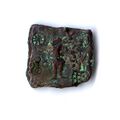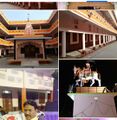Ujjain
| Author:Laxman Burdak, IFS (R) |

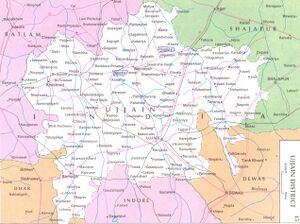
Ujjain (Hindi:उज्जैन) is an ancient city of central India, in the Malwa region of the Indian state of Madhya Pradesh, on the eastern bank of the Kshipra River. Avanti people fought Mahabharata War in Kaurava's side
Location
It is the administrative centre of Ujjain District and Ujjain Division. It is 189 km away from State capital Bhopal and 60 km away from Indore.
Variants
- Bhogavati (भोगवती-1) = Ujjayini (उज्जयिनी) (दे. अवन्ती) (AS, p.679)
- Avanti (अवंती) = उज्जैन (म. प्र.) (AS, p.45)
- Avantikapuri
- Ojein
- Ujain
- Ujjayini (उज्जयिनी) दे. अवन्ती (AS, p.87)
- Amaravati (अमरावती) (2) = उज्जैन (AS, p.32)
- Shivapuri (शिवपुरी) (1) = उज्जैन (AS, p.901)
- Padmavati (पद्मावती-1) (AS, 525) = Ujjayini (उज्जयनी)
- Vishālā विशाला (1) = Ujjayini (उज्जयिनी) (AS, p.863)
Tahsils in Ujjain
- Badnagar (बड़नगर)
- Ghatiya (घटिया)
- Khacharod (खाचरोद)
- Mahidpur (माहिदपुर)
- Nagda (नागदा)
- Tarana (तराना)
- Ujjain (उज्जैन)
- Makdoun (माकडोन)
- Jharda (झार्डा)
- Ujjain Nagar (उज्जैन नगर)
- Kothi Mahal (कोठी महल)
Villages in Ujjain tahsil
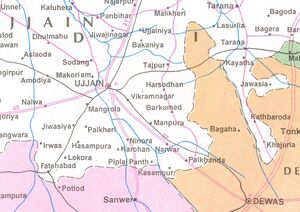
Ajrana, Akasoda, Alampur (Udana), Amirpur Kuslakhedi, Amirpur (Fajalpur), Aslana, Badalkhedi, Badarkha Berasiya, Badhkummed, Badodiya Bhand, Bakaniya, Bamora, Banskhedi Khalsa, Bhainsoda, Bhanwri, Biaora, Bodani, Bolasa, Brijrajkhedi, Chakjai Rampur, Chandesara, Chandesari, Chandmukh, Chandukhedi, Chenpur Hanskhedi, Chhayan, Chintaman Jawasiya, Datana, Daudkhedi, Daukhedi, Derkhedi, Dewankhedi, Dewarakhedi Buzurg, Dewarkhedi Khurd, Dhabla Rehwari, Dhatrawada, Dhediya, Dudarsi, Erwas, Fatehabad, Gangedi, Gaowdi, Gondiya, Gothada, Gunaikhalsa, Hakkanipura, Hamirkhedi, Harnawada, Harnyakhedi, Harsodan, Hasampura, Jaiwantpur, Jalalkhedi, Jamalpura, Jambura, Jarkhoda, Jastikhedi, Jawasiya Kumar, Jhiaroliya, Jiwankhedi, Kachnariya, Kadchha, Kadchhali, Kalyanpura, Kandariya, Kankariya Chirakhan, Karadiya(Nawakheda), Karohan, Karondiya, Kasampur, Kesoni, Khajuria Rehwari, Khajuriya Kumawat, Kharent, Khemasa, Khetiyakhedi, Khokariya, Kithodarao, Kokalakhedi, Kuwariya, Lekoda, Limbapiplya, Madhopur, Magariya, Mangrola, Manpura, Matanakalan, Matanakhurd, Mediya, Molakhedi, Mundlasuleman, Munjakhedi, Nahariya, Nalwa, Narwar, Nayakhedi, Nikewadi, Nilkanth, Nilora, Nogawan, Palkhanda, Palkhedi, Panthpiplai, Pingleshwar, Piploda Dwarkadish, Piplyabichha, Piplyaragho, Ramjankhedi, Ramwasa, Ranabad, Ratnakhedi, Sabalpur (Buchakhedi), Sahabkhedi, Samadiya, Sawara Khedi, Sayarkhedi, Semaliyanasar, Sewarkhedi, Sikandari, Silarkhedi, Silodamori, Surjanwasa, Tajpur, Takwasa, Talod, Tankariya Kazi, Tankariyapanth, Ujjain (M Corp.), Umariya Jagir, Umariya Khalsa, Undasa,
Lord Shiva and Ujjain
The legend goes that when Lord Shiva founded Ujjain at the behest of Parvati on the banks of Shipra, four gates were established to guard the city from all four directions. Four guardian deities Pingaleshwar (East), Kayavarohaneshwar (South), Dardureshwar (North) and Bilveshwar (West) were appointed with Mahakaleshwar at centre of the town.
Various Names of Ujjain
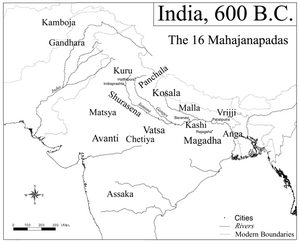
Since Ujjain is one of the oldest cities in India, it has been known by very many names, among which were as under:[1] Out of them some have relations with Jat clans given with each name.
- Avantika
- Padmavati - According to historian RS Joon, the naga dynasty belonged to Madrak Jat gotra of Yadav Vansh and was devotees of Shiva. They had a number of ruling dynasties such as Takshak Nag, Bachak Nag, Kilkil Nag, Karkotaka, Kaliramna etc all of which are Jat gotras. Mathura, Padmavati and Kantipur were capitals of Naga dynasty. Nagas of Padmavati were called Taank, which is also a Jat gotra, and are found in 24 villages near Sonipat.[2]
- Kushasthali - Kusha is the ancestor of Kushwah or Kaswan clan of Jats.[3]
- Bhagavati
- Haranyavati - Haran (हारण) gotra Jats live in Mandsaur district in Madhya Pradesh. The village in Mandsaur district with Haran population is Pipalkhuta.
- Kandakatringa
- Kumudvati - Kumud (कुमुद) is a gotra of Jats. This gotra started after Naga named Kumuda. [4] Kumud was one of combatants armed with diverse weapons and clad in diverse kinds of robes and ornaments, that Skanda procured at the time of ceremony of investiture. (See - Shalya Parva in Mahabharata)
- Pratikalpa
- Vishala
In Mahabharata
Avanti (अवन्ति) (D) (III.87.1), (3-255-17), (V.19.24),
Avantya (ऽवन्तय)/ आवन्त्य (II.28.10),(VI.10.41),(VI.47.17), (VI.52.7), (VI.83.6),
Karna's conquests: Vana Parva, Mahabharata/Book III Chapter 255 describes Karna's victory march and countries subjugated. Avanti (अवन्ति) is mentioned in (3-255-17). [5] ....Then going to Shishupala's son (शैशुपाल) (3-255-16a), the son of the Suta defeated him and that highly powerful one also brought under his sway all the neighbouring rulers. And, O bull of the Bharata race, having subjugated the Avantis (3-255-17a) and concluded peace with them, and having met with the Vrishnis (वृष्णि) (3-255-17b ), he conquered the west.
In Mahavansa
Mahavansa/Chapter 5 tells that ....The sons of Kalasoka were ten brothers, twenty-two years did they reign in Magadha. Afterwards, the nine Nandas were kings in succession; they too reigned twenty-two years in Magadha. Then did the brahman Canakka anoint a glorious youth, known by the name Candagutta, as king over all Jambudipa, born of a noble clan, the Moriyas, when, filled with bitter hate, he had slain the ninth (Nanda) Dhanananda.
Twenty-four years he reigned, and his son Bindusära reigned twenty-eight. A hundred glorious sons and one had Bindusara; Asoka stood high above them all in valour, splendour, might, and wondrous powers. He, when he had slain his ninety-nine brothers born of different mothers, won the undivided sovereignty over all Jambudipa. Be it known, that two hundred and eighteen years had passed from the nibana of the Master unto Asoka's consecration.
Four years after the famous (Asoka) had won for himself the undivided sovereignty he consecrated himself as king in the city Pataliputta. Straightway after his consecration his command spread so far as a yojana (upward) into the air and downward into the (depths of the) earth.'
Mahavansa/Chapter 5 further tells that .... Nigrodha was the son of prince Sumana, the eldest brother of all the sons of Bindusara. When Bindusära had fallen sick Asoka left the government of Ujjeni conferred on him by his father, and came to Pupphapura, and when he had made himself master of the city, after his father's death, he caused his eldest brother to be slain and took on himself the sovereignty in the splendid city.
The consort of prince Sumana, who bore the same name (Sumana), being with child, fled straightway by the east gate and went to a candala village, and there the guardian god of a nigrodha-tree called her by her name, built a hut and gave it to her.
Mention by Panini
Avanti (अवन्ति) is a term mentioned by Panini in Ashtadhyayi. [6]
Avantī (अवन्ती) is a term mentioned by Panini in Ashtadhyayi. [7]
Ujjayini (उज्जयिनी) is name of a place mentioned by Panini in Ashtadhyayi under Varanadi (वरणादि) (4.2.82) group. [8]
Ujjayani (उज्जयनी) is name of a Country mentioned by Panini in Ashtadhyayi under Dhumadi (धूमादि) (4.2.127) group.[9]
V. S. Agrawala[10] writes that Ashtadhyayi of Panini mentions janapada Avanti (अवन्ति) (IV.1.175) - An independent kingdom with capital Ujjayani.
History
In ancient times the city was called Ujjayini. As per epic Mahabharata Ujjayani was the capital of Avanti Kingdom. It has been the first meridian of longitude for Hindu geographers since the 4th century BCE. It is one of the seven sacred cities of the Hindus, and the Kumbh Mela religious festival is held there every twelve years. It is also home to Mahakaleshwar Jyotirlinga, one of the twelve Jyotirlinga shrines to the god Shiva.
The earliest references to the city, as Ujjaini, are from the time of the Buddha, when it was the capital of the Avanti Kingdom. Since the 4th century B.C. the city has marked the first meridian of longitude in Hindu geography. It is also reputed to have been the residence of Ashoka (who subsequently became the emperor), when he was the viceroy of the western provinces of the Maurya empire.
James Tod[11] writes that The translator of the Periplus of the Erythrean Sea, following D'Anville[12], makes Ozene (Ujjain) the capital of a Porus, who sent an embassy to Augustus to regulate their commercial intercourse.
James Tod[13] notes that This Porus is a corruption of Puar, once the most powerful and conspicuous tribe in India ; classically written Pramara, the dynasty which ruled at Ujjain for ages. [14]
Rajatarangini[15] tells that the king of Kashmir Hiranya died after a reign of thirty years and two months without leaving any issue. At this time there reigned a powerful king at Ujjayini named Vikramaditya otherwise called Harsha. He subdued the whole world, and destroyed the Shakas, a Mlechchha tribe. Rajatarangini[16] further writes the period of reign from 89-120 AD.
In the Post-Mauryan period, the city was ruled by the Sungas and the Satavahanas consecutively. It was contested for a period between the Satavahanas and the Indo-Scythian Sakas, known as Western Satraps; however, following the end of the Satavahana dynasty, the city was retained by the Sakas from the 2nd to the 4th century CE. Following the conquest of the Sakas by the Guptas, the city soon became an important seat in the annals of that empire. Ujjain is considered to be the traditional capital of King Chandragupta II, also known as Vikramaditya, at whose court the nine poets known as the navaratna (nine jewels) of Sanskrit literature are said to have flourished.
Rajatarangini[17] mentions the victory of Kashmira king Lalitaditya over various kingdoms. ...He marched thence with his army towards the east. He passed Kalingga, where elephants were caught. And then he came to Goura. Thence he reached the Eastern Sea, and pursued his course along the coast towards the south, conquering as he went. Karnāta submitted on his approach. A beautiful Karnāti lady named Ratti who ruled supreme in the south, her territories extending
[p.69]: as far as the Vindhya hills, also submitted to him. The army then rested on the banks of the Kaveri beneath the palm trees, drinking the water of coconuts. Thence he marched to Chandanadri. And then the king crossed the sea passing from one Island to another ; and thence marched towards the west, the sea singing the songs of his victory. He then attacked the seven Kramuka and the seven Kongkana which suffered much thereby. His army was anxious to enter Dvaraka situated on the Western Sea. The army then crossed the Vindhya hills and entered Avanti where there was an image of Shiva named Mahakala.
In the 6th and 7th centuries, Ujjain was a major centre of mathematical and astronomical research. The famous mathematicians who worked there included: Brahmagupta, whose book Brahmasphutasiddhanta was responsible for spreading the use of zero, negative numbers and the positional number system to Arabia and Cambodia; Varahamihira, who was the first to discover many trigonometric identities; and Bhaskaracharya, or Bhaskara II, whose book Lilavati broke new ground in many areas of mathematics.
Ujjain was invaded by the forces of the Delhi Sultanate led by Iltutmish in 1235, suffering widespread destruction and systematic desecration of temples. Under the Mughal emperor Akbar it became the capital of Malwa.
During the last half of the 18th century Ujjain was the headquarters of the Maratha leader Sindhia. The Sindhias later established themselves at Gwalior, and Ujjain remained part of Gwalior state until Indian Independence in 1947. Gwalior state became a princely state of the British Raj after the Maratha defeat in the Third Anglo-Maratha War, and Gwalior, Ujjain, and the neighboring princely states were made a part of the Central India Agency. After Indian independence, the Sindhia ruler of Gwalior acceded to India, and Ujjain became part of the Madhya Bharat state. In 1956 Madhya Bharat was merged into Madhya Pradesh state.
Dasharatha Sharma[18] writes....[p.123]: Hammira was the last and most famous of the Chauhans of Ranthambhor. Hammira had ascended the throne in V.1339. Not very long after this, he started, according to the Hammiramahakavya, on a digvijaya or conquest of all the quarters. He first defeated Ajuna, the ruler of Bhamarasa, and then exacted tribute from the fort of Mandalakrita (मण्डलकृत) or Mandalgarh. Striking southwards from here, he reached Ujjayini and Dhara and defeated the Paramara ruler Bhoja. From here he turned northwards, and reached home passing through Chittor, Abu, Vardhanapura (वर्धनपुर) (Badnore), Changa (चंगा) (fortress of the mers still retains old name), Pushkar, Maharashtra (Marot), Sakambhari, Khandilla (खंडिल्ल) (Khandela), Champa (चम्पा) (Chaksu), and Karkarala (कर्कराला) (Karkaralagiri of the Balvan Inscription == Karauli), at the last of which places he received the homage of the ruler of Tribhuvanagiri (Tahangarh).
[p.124]: after came a Koti-yajna which was very much like the asvamedha of Samudragupta. It was under the direction of his purohita Vishvarupa. This digvijaya, or rather a number of raids from time to time magnified into one systematic digvijaya (Balvan Inscription, EI, XIX, pp.49 ff) by Nayachandra, took place before V. 1345 (c. 1288 A.D.). The Balvan inscription of the year mentions the performance of not only one but two Kotiyagna by Hammira and describes the capture of the elephant force of Arjuna, the ruler of Malwa, a kingdom the condition of which was indeed bad enough to invite interference from all sides.
Indian Origin Places in Burma
Dineschandra Sircar[19] writes.... Some important old Indian names found in Burma are Aparanta, Avanti, Varanasi, Champanagara, Dvaravati, Gandhara, Kamboja, Kailasha, Kusumapura, Mithila, Pushkara, Pushkaravati, Rajagriha, etc. and the names Sankashya (Tagaung on the Upper Irawadi), Utkala (from Rangoon to Pegu) and Vaishali (modern Vethali in the Akyub district also fall in the same category.[20] The name of the well-known river Irawadi reminds us of Iravati (modern Ravi River), one of the famous tributaries of the Indus.
In Mahabharata
Military Campaign of Karna: Mahabharata, Book 3, Chapter 252.... And, O bull of the Bharata race, having subjugated the Avantis and concluded peace with them, and having met with the Vrishnis, he conquered the west.
Visit of Xuanzang in 641 AD
Alexander Cunningham[21] writes that Hwen Thsang describes the capital of U-she-yen-na, or Ujjayini, as 30 li, or 5 miles, in circuit, which is only a little less than its size at the present day. The kingdom was 6000 li, or 1000 miles, in circuit. To the west it was bounded by the kingdom of Malwa, with its capital of Dhara-nagar, or Dhar, within 50 miles of Ujain. The territory of Ujain could not therefore have extended westward beyond the Chambal river, but to the north it must have been bounded by the kingdoms of Mathura and Jajhoti; to the east by Maheswarapura, and to the south by the Satpura mountains running between the Narbada and the Tapti. Within these limits, that is from Ranthambhawar and Burhanpur on the west, to Dumoh and Seoni on the east, the circuit of the territory assigned to Ujain is about 900 miles.[22]
The kingdom of Ujain was under the rule of a Brahman Raja, like the two neighbouring states of
[p.490]: Jajhoti and Maheswarapura ; but the king of Jajhoti was a Buddhist, while the other two kings were Brahmanists. To the west, the king of Malwa was a staunch Buddhist. But the Mo-la-po, or Malwa, of Hwen Thsang is limited to the western half of the ancient province, the eastern half forming the Brahmanical kingdom of Ujain. As the political divisions of the province thus correspond with its religious divisions, it may fairly be inferred that the rupture was caused by religious dissensions. And further, as the western or Buddhist half of the province still retained the ancient name of Malwa, I conclude that the Brahmanists were the seceders, and that the kingdom of Ujain was a recent Brahmanical offshoot from the old Buddhist kingdom of Malwa. Similarly, I believe that Maheswarapura must have been a Brahmanical offshoot from the great Buddhist kingdom of Kosala, or Berar, which will be described hereafter. In Ujain, there were several dozens of monasteries, but at the time of Hwen Thsang's visit, there were only three or four not in ruins, which gave shelter to about 300 monks. The temples of the gods were very numerous, and the king himself was well versed in the heretical books of the Brahmans.
सप्तपुरी
सप्तपुरी (AS, p.933): पुराणों में वर्णित सात मोक्षदायिका पुरियों को कहा गया है। इन पुरियों में 'काशी', 'कांची' (कांचीपुरम), 'माया' (हरिद्वार), 'अयोध्या', 'द्वारका', 'मथुरा' और 'अवंतिका' (उज्जयिनी) की गणना की गई है - 'काशी कांची चमायाख्यातवयोध्याद्वारवतयपि, मथुराऽवन्तिका चैताः सप्तपुर्योऽत्र मोक्षदाः'; 'अयोध्या-मथुरामायाकाशीकांचीत्वन्तिका, पुरी द्वारावतीचैव सप्तैते मोक्षदायिकाः।' [23]
महाकाल
विजयेन्द्र कुमार माथुर[24] ने लेख किया है ...महाकाल (AS, p.721): उज्जैन में स्थित भगवान शिव का अति प्राचीन मंदिर है. इसका वर्णन कालिदास ने मेघदूत, (पूर्वमेघ, 36 तथा अनुवर्ती छंद में किया है--'अप्यन्यस्मिञ्जलधर महाकालमासाद्य काले, स्थातव्यं ते नयनविषयं यावदत्येति भानुः, कुर्वन् सन्ध्याबलिपटहतां शूलिनः श्लाघनीयाम्, आमन्द्राणां फलमविकलं लप्स्यसे गर्जितानाम्'--आदि.
रघुवंश 6,34 में इंदुमती-स्वयंवर के प्रसंग में अवंती नरेश के परिचय के संबंध में भी महाकाल का वर्णन है-- 'असौ महाकालनिकेतनस्य वसन्नदूरे किल चन्द्रमौलेः, तमिस्रपक्षेऽपि सह प्रियाभिर्ज्योत्स्नावतो निर्विशति प्रदोषान्'.
उज्जयिनी को प्राचीन काल में ज्योतिष-विद्या का घर माना जाता था. इस नगरी में प्राचीन काल में भारतीय कालक्रम की गणना का केंद्र होने के कारण भी महाकाल मंदिर का नाम सार्थक जान पड़ता है (प्राचीन भारत में ज्योतिष विद्या विशारदों ने कालक्रम मापने के लिए उज्जयिनी में शून्य ने अक्षांश की स्थिति मानी थी जैसा कि वर्तमान काल में ग्रीनिच में है). जयपुर नरेश जयसिंह द्वितीय ने एक प्रसिद्ध वेधशाला भी यहां बनवाई थी. महाकाल का मंदिर उज्जैन में आज भी है किंतु यह कालिदास द्वारा वर्णित प्राचीन मंदिर से अवश्य भिन्न है. प्राचीन मंदिर को गुलाम वंश के सुल्तान इल्तुतमिश ने 13वीं शती में नष्ट कर दिया था. नवीन मंदिर प्राचीन देवालय के स्थान पर ही बनाया गया जान पड़ता है. यह मंदिर भूमि के नीचे गहरे स्थान में बना हुआ है. पास ही शिप्रा नदी बहती है जिसका वर्णन कालिदास ने महाकाल मंदिर के प्रसंग में किया है.
उज्जयिनी
विजयेन्द्र कुमार माथुर[25] ने लेख किया है ...उज्जयिनी (AS, p.87) महाभारत अनुशासन पर्व में विश्वामित्र के एक पुत्र उज्जयन का नाम मिलता है। संभव है उज्जयिनी का नाम इसी के नाम पर हो। भास के नाटक 'स्वप्नवासवदत्ता' में अवंति तथा उज्जयिनी-इन दोनों ही नामों का उल्लेख है- 'एष उज्जयिनीयो ब्राह्मण:', जिससे नाम की अतिप्राचीनता सिद्ध होती है। उज्जयिनी के कई नाम संस्कृत साहित्य में मिलते हैं जिनमें मुख्य हैं- अवंती, विशाला, भोगवती, हिरण्यवती और पद्मावती।
अवंती
विजयेन्द्र कुमार माथुर[26] ने लेख किया है ...
1. अवंती = उज्जयिनी (AS, p.45): अवंती, पौराणिक 16 महाजनपदों में से एक था। आधुनिक मालवा का प्रदेश जिसकी राजधानी उज्जयिनी और महिष्मति थी। उज्जयिनी (उज्जैन) मध्य प्रदेश राज्य का एक प्रमुख शहर है। प्राचीन संस्कृत तथा पाली साहित्य में अवंती या उज्जयिनी का सैंकड़ों बार उल्लेख हुआ है। महाभारत सभा 31, 10 में सहदेव द्वारा अवंती को विजित करने का वर्णन है। बौद्ध काल में अवंती उत्तरभारत के शोडश महाजनपदों में से थी जिनकी सूची अंगुत्तरनिकाय में हैं। जैन ग्रंथ भगवती सूत्र में इसी जनपद को मालव कहा गया है। इस जनपद में स्थूल रूप से वर्तमान मालवा, निमाड़ और मध्य प्रदेश का बीच का भाग सम्मिलित था।
पुराणों के अनुसार अवंती की स्थापना यदुवंशी क्षत्रियों द्वारा की गई थी। बुद्ध के समय अवंती का राजा चंडप्रद्योत था। इसकी पुत्री वासवदत्ता से वत्सनरेश उदयन ने विवाह किया था जिसका उल्लेख भास रचित 'स्वप्नवासवदत्ता' नामक नाटक में है। वासवदत्ता को अवन्ती से सम्बंधित मानते हुए एक स्थान पर इस नाटक में कहा गया है-'हम! अतिसद्दशी खल्वियमार्याय अवंतिकाया: (स्वप्नवासवदत्ता अंक 6) चतुर्थ शती ई. पू. में अवन्ती का जनपद मौर्य-साम्राज्य में सम्मिलित था और उज्जयिनी मगध-साम्राज्य के पश्चिम प्रांत की राजधानी थी। इससे पूर्व मगध और अवन्ती का संघर्ष पर्याप्त समय तक चलता रहा था जिसकी सूचना हमें परिशिष्टपर्वन (परिशिष्टपर्वन पृ. 42) से मिलती है। 'कथासरित्सागर' (टॉनी का अनुवाद जिल्द 2, पृ. 484) से यह ज्ञात होता है कि अवन्तीराज चंडप्रद्योत के पुत्र पालक ने कौशाम्बी को अपने राज्य में मिला लिया था। विष्णु पुराण (विष्णु पुराण 4,24,68) से विदित होता है कि संभवत: गुप्त काल से पूर्व अवन्ती पर आभीर इत्यादि शूद्रों या विजातियों का आधिपत्य था-'सौराष्ट्रावन्ति…विषयांश्च--आभीर शूद्राद्या भोक्ष्यन्ते'। ऐतिहासिक परम्परा से हमें यह भी विदित होता है कि प्रथम शती ई. पू. में (57 ई. पू. के लगभग) विक्रम संवत के संस्थापक किसी अज्ञात राजा ने शकों को हराकर उज्जयिनी को अपनी राजधानी बनाया था। गुप्त काल में चंद्रगुप्त विक्रमादित्य ने अवंती को पुन: विजय किया और वहाँ से विदेशी सत्ता को उखाड़ फैंका। कुछ विद्वानों के मत में 57 ई. पू. में विक्रमादित्य नाम का कोई राजा नहीं था और चन्द्रगुप्त द्वितीय ने ही अवंती-विजय [p.46]: के पश्चात् मालव संवत को जो 57 ई. पू. में प्रारम्भ हुआ था, विक्रम संवत का नाम दे दिया।
युवानच्वांग का वर्णन: चीनी यात्री युवानच्वांग के यात्रावृत से ज्ञात होता है कि अवन्ती या उज्जयिनी का राज्य उस समय (615-630 ई.) मालव राज्य से अलग था और वहाँ एक स्वतन्त्र राजा का शासन था। कहा जाता है शंकराचार्य के समकालीन अवन्ती-नरेश सुधन्वा ने जैन धर्म का उत्कर्ष सूचित करने के लिए प्राचीन अवन्तिका का नाम उज्जयिनी (विजयकारिणी) कर दिया था किन्तु यह केवल कपोल कल्पना मात्र है क्योंकि गुप्तकालीन कालिदास को भी उज्जयिनी नाम ज्ञात था, 'वक्र: पंथा यदपि भवत: प्रस्थिस्योत्तराशां, सौधोत्संगप्रणयविमुखोमास्म भूरुज्जयिन्या:'(पूर्वमेघ. 29) इसके साथ ही कवि ने अवन्ती का भी उल्लेख किया है-'प्राप्यावन्तीमुदयनकथाकोविदग्रामवृद्धान्' (पूर्वमेघ. 32) इससे संभवत: यह जान पड़ता है कि कालिदास के समय में अवन्ती उस जनपद का नाम था, जिसकी मुख्य नगरी उज्जयिनी थी।
9 वीं व 10 वीं शतियों में उज्जयिनी में परमार राजाओं का शासन रहा। तत्पश्चात् उन्होंने धारा नगरी में अपनी राजधानी बनाई। मध्यकाल में इस नगरी को मुख्यत: उज्जैन ही कहा जाता था और इसका मालवा के सूबे के एक मुख्य स्थान के रूप में वर्णन मिलता है। दिल्ली के सुल्तान इल्तुतमिश ने उज्जैन को बुरी तरह से लूटा और यहाँ के महाकाल के अति प्राचीन मन्दिर को नष्ट कर दिया। ( यह मन्दिर संभवत: गुप्त काल से भी पूर्व का था। मेघदूत, पूर्वमेघ 36 में इसका वर्णन है--'अप्यन्यस्मिन् जलधर महाकालमासाद्यकाले')
अगले प्राय: पाँच सौ वर्षों तक उज्जैन पर मुसलमानों का आधिपत्य रहा। 1750 ई. में सिंधिया नरेशों का शासन यहाँ स्थापित हुआ और 1810 ई. तक उज्जैन में उनकी राजधानी रही। इस वर्ष सिंधिया ने उज्जैन से हटा कर राजधानी ग्वालियर में बनाई। मराठों के राज्यकाल में उज्जैन के कुछ प्राचीन मन्दिरों का जीर्णोद्धार किया गया था। इनमें महाकाल का मन्दिर भी है। यहीं से शिव ने त्रिपुर पर विजय प्राप्त की थी, अत: इसका नाम उज्जयिनी पड़ा।
जैन ग्रन्थ विविधतीर्थ कल्प में मालवा प्रदेश का ही नाम अवंति या अवंती है। राजा शंबर के पुत्र अभिनंदन देव का चैत्य अवन्ति के मेद नामक ग्राम में स्थित था। इस चैत्य को मुसलमान सेना ने नष्ट कर दिया था किन्तु इस ग्रन्थ के अनुसार वैज नामक व्यापारी की तपस्या से खण्डित मूर्ति फिर से जुड़ गई थी।
उज्जयिनी के वर्तमान स्मारकों में मुख्य, महाकाल का मन्दिर क्षिप्रा नदी के तट पर भूमि के नीचे बना है। इसका निर्माण प्राचीन मन्दिर के स्थान पर रणोजी सिंधिया के मन्त्री रामचन्द्र बाबा ने 19 वीं शती के उत्तरार्ध में करवाया था। [p.47]: महाकाल की शिव के द्वादश ज्योतिर्लिगों में गणना की जाती है। इसी कारण इस नगरी को शिवपुरी भी कहा गया है।
हरसिद्धि का मन्दिर कहा जाता है, उसी प्राचीन मन्दिर का प्रतिरूप है जहाँ विक्रमादित्य इस देवी की पूजा किया करते थे। राजा भतृहरि की गुफ़ा संभवत: 11 वीं शती का अवशेष है। चौबीस खम्भा दरवाज़ा शायद प्राचीन महाकाल मन्दिर के प्रांगण का मुख्य द्वार था। कालीदह-महल 1500 ई. में बना था। यहाँ की प्रसिद्ध वेधशाला जयपुर-नरेश जयसिंह द्वितीय ने 1733 ई. में बनवाई थी। वेधशाला का जीर्णोद्धार 1925 ई. में किया गया था।
प्राचीन अवंती वर्तमान उज्जैन के स्थान पर ही बसी थी, यह तथ्य इस बात से सिद्ध होता है कि क्षिप्रा नदी जो आजकल भी उज्जैन के निकट बहती है, प्राचीन साहित्य में भी अवंती के निकट ही वर्णित है।[9] उज्जैन से एक मील उत्तर की ओर भैरोगढ़ में दूसरी-तीसरी शती ई. पू. की उज्जयिनी के खंडहर पाए गए हैं। यहाँ वेश्या-टेकरी और कुम्हार-टेकरी नाम के टीले हैं जिनका सम्बन्ध प्राचीन किंवदंतियों से है।
2. अवंती (AS, p.47) (बर्मा): ब्रह्मदेश की प्राचीन नगरी थी जिसे संभवत: उज्जयिनी से ब्रह्मदेश में आकर बस जाने वाले भारतीय औपनिवेशकों ने बसाया था.
उज्जैन का इतिहास
क्षिप्रा के पूर्वी तट पर स्थित भारत की महाभागा-अनादि नगरी उज्जयिनी को भारत की सांस्कृतिक-काया का मणिपुर-चक्र माना गया है. इसे भारत की मोक्षदायिका सात प्राचीन पुरियों में एक माना गया है. प्राचीन विश्व की शून्य देशांतर रेखा यहीं से गुजरती है. पुरानों में उज्जयिनी, अवंतिका, अमरावती, प्रतिकल्पा, कुमुद्धती आदि नामों से इसकी महिमा गाई गयी है. महाकवि कालिदास द्वारा वर्णित "श्री विशाला विशाला" एवं भाणों में उल्लिखित "सार्वभौम" नगरी यही रही है. इस नगरी से ऋषि सांदीपनि , महाकात्यायन, भास, सिद्धसेन, दिवाकर, भर्तृहरि , कालिदास, वराहमिहिर, अमरसिंहादि नवरत्न, परमार्थ, शूद्रक, हरिषेण, शंकराचार्य, वल्लभाचार्य, जदरूप आदि संस्कृतिचेता महापुरुषों का घनीभूत सम्बन्ध रहा है.
राजनैतिक इतिहास उज्जैन का काफी लम्बा रहा है. उज्जैन के गढ़ क्षेत्र से हुयी खुदाई में आद्यैतिहासिक (protohistoric ) एवं प्रारंभिक लोहयुगीन सामग्री प्रचुर मात्र में प्राप्त हुई है. पुरानों व महाभारत में उल्लेख आता है की वृष्णि-वीर कृष्ण व बलराम यहाँ गुरु सांदीपनी के आश्रम में विद्याप्राप्त करने हेतु आये थे. कृष्ण की एक पत्नी मित्रवृन्दा उज्जैन की ही राजकुमारी थी. उसके दो भाई विन्द एवं अनुविन्द महाभारत युद्ध में कौरवों की और से युद्ध करते हुए वीर गति को प्राप्त हुए थे. ईसा की छठी सदी में उज्जैन में एक अत्यंत प्रतापी राजा हुए जिनका नाम चंड प्रद्योत था. भारत के अन्य शासक उससे भय खाते थे. उसकी दुहिता वासवदत्ता एवं वत्सनरेश उदयन की प्रणय गाथा इतिहास प्रसिद्द है. प्रद्योत वंश के उपरांत उज्जैन मगध साम्राज्य का अंग बन गया.
मौर्य सम्राट चन्द्रगुप्त मौर्य यहाँ आया था. उसका पुत्र अशोक यहाँ का राज्यपाल रहा था. उसकी एक भार्या वेदिसा देवी से उसे महेंद्र और संघमित्रा जैसी संतान प्राप्त हुई जिसने कालांतर में श्रीलंका में बौद्ध धर्म का प्रचार किया था. मौर्य साम्राज्य के पतन के बाद उज्जैन शकों और सातवाहनों की प्रतिस्पर्धा का केंद्र बन गया. शकों के पहले आक्रमण को उज्जैन के वीर विक्रमादित्य के नेतृत्व में यहाँ की जनता ने प्रथम सदी ईसा पूर्व विफल कर दिया था. कालांतर में विदेशी पश्चिमी शकों ने उज्जैन हस्त गत कर लिया. चस्टान व रुद्रदमन इस वंश के प्रतापी व लोक प्रिय महाक्षत्रप सिद्ध हुए. चौथी सताब्दी ई. में गुप्तों और औलिकरों ने मालवा से इन शकों की सत्ता समाप्त कर दी. शकों और गुप्तों के काल में इस क्षेत्र का अद्वितीय आर्थिक एवं औद्योगिक विकास हुआ. छठी से दसवीं सदी तक उज्जैन कलचुरियों, मैत्रकों, उत्तरगुप्तों (Later Guptas) पुष्यभूतियों , चालुक्यों, राष्ट्रकूटों व प्रतिहारों की राजनैतिक व सैनीक स्पर्धा का दृश्य देखता रहा. सन १००० से १३०० ई.तक मालवा परमार-शक्ति द्वारा शासित रहा. काफी समय तक उनकी राजधानी उज्जैन रही. इस काल में सीयक द्वितीय, मुंजदेव, भोजदेव, उदयादित्य, नरवर्मन जैसे महान शासकों ने साहित्य, कला एवं संस्कृति की अभूतपूर्व सेवा की.
दिल्ली के दास एवं खिलजी सुल्तानों के आक्रमण के कारण परमार वंश का पतन हो गया. सन १४०६ में मालवा दिल्ली सल्तनत से मुक्त हो गया और उसकी राजधानी मांडू से धोरी, खिलजी व अफगान सुलतान स्वतंत्र राज्य करते रहे. मुग़ल सम्राट अकबर ने जब मालवा अधिकृत किया तो उज्जैन को प्रांतीय मुख्यालय बनाया गया. मुग़ल बादशाह अकबर, जहाँगीर, शाहजहाँ व औरंगजेब यहाँ आये थे.
अठारवीं सदी के पूर्वार्ध में मालवा पर मराठों का अधिकार हो गया. सिंधिया वंश की राजधानी उज्जैन बनी. इस वंश के संस्थापक राणोजी शिंदे के मंत्री रामचंद्र शेणवी ने वर्तमान महाकाल मंदिर का निर्माण करवाया. सन १८१० में सिंधिया राजधानी ग्वालियर ले जाई गयी किन्तु उज्जैन का संस्कृतिक विकास जारी रहा. १९४८ में ग्वालियर राज्य का नवीन मध्य भारत में विलय हो गया.
जाटों का शासन-विधान
ठाकुर देशराज [27] ने लिखा है... अब हमें यह विचार करना है कि प्राचीन भारत के वे खानदान जो जाटों में शामिल हैं उन्होंने कौन-कौन सी हुकूमतों को चलाया था।
कांभोज, कुंतीभोज और अवंती ये सब भौज्य पद्धति से शासन करते थे। भूमि में जो भी कुछ पैदा होता था उसका एक निश्चित अंश केंद्रीय सभा को देते थे। केंद्रीय सभा में परिवारों की ओर से कुलपति बैठते थे। यह सभा कुलक कहलाती थी। यह लोग राजस्व को कुआ बावड़ी खुदवाने, बाग लगाने और सेना रखने में खर्च करते थे। भोज लोगों की ही एक शाखा प्रमार कहलाने लगी थी। द्वारिका का जाति राष्ट्र भौज्य राज्य भी कहलाता था। कुछ लोग भौज्य के अर्थ संयुक्त शासन के भी करते हैं।
Jat Gotras/History connection with Ujjain
- Pachar/Pawar - Pachar or Pachehra is degenerated form of Panwar. Their origin was at Dharanagari. Sujan Singh was their chieftain. Sujan Singh won the places Udiya, Amber, Ujjain, Averi, Abugarh and Sanganeri, which were in the territory of Rajarao. He defeated the five states so they were called Pachehra. Sujan Singh progressed further and also won Hindon, Bayana and Gwalior forts. Sujan Singh established villages Dhahrooa, Kanarai. He also defeated Kalars who had great nuisance and had dominance in Brij area.
- Tevatia - Tevatia Jats believe that they have migrated from village named Tevti/Teoti. There is one village of this name in Bharatpur. There is also a village of this name near Ujjain. River Tapti is considered to be named after this gotra. Country Tibet is also believed to be named after this gotra.
- Dabas - According to puranic legend Dabas are the descendants of Maharishi Dadhichi the great king of Sindh in Vedic period. He had four sons namely Dahiya, Davyas (Dabas), Kundu and Hooda. Dadhichi an emperor turned Maharishi died at the age of 100 years while fighting to non-Aryan tribes. In the battle his four sons fought with utmost bravery and annihilated the non-Aryans. The epic makers goes on to prove that the families of Dahiya, Dabas, Kundu and Hooda lived together up to the times of Mahabharat in the shape of groups like Soorsaini, Vrishni and Bhoja. They lived in Ujjain, Avantika, Sambal, Indraprastha, Rajasthan and other Northern India parts up to 7th Century AD.
- Bidiyasar:From the history of Bidyasar gotra we know that they are the descendants of king Bidya Datta (बिद्यादत्त) who ruled over Ujjain during 9th century. It is said that the ruling family of Mysore state is "Vadyar" by gotra and are the descendant of king Bidya Datta.
- In Rajasthan, they first came to Runicha (Jaisalmer) and then to Rarod (Tah. Bhopalgarh in Jodhpur) and Rataoo (Tahsil- Ladnu in Nagaur) in 12th century and occupied the position of village Chaudhary. His son Kanwsi, a great devotee of "Goddess Dadhimati" of Goth Mangalod later on changed the name of Dhasunda to Khiyala. Bidyasar Choudhary of Khiyala used to collect land revenue on behalf of Delhi throne for three decades , before Jodhpur state was carved out.
Jat Gotras in Ujjain
Sunda inscription
Bhim Singh Dahiya writes that-
- "I'd like to mention that while Jats are mentioned they were never noticed by Indian historians deliberately. One is from Sunda inscription of Sinda chief Chavunda, which says that "just as Amravati looked ever beautiful with Indra, or Ayodhya with the descendants of Raghu, Mathura with Govinda, Ujjayni with Gutta, and Hastinapur with son of Marut (Bhima); so also Erambarapura attained gracefulness with Sinda Chief Chavunda". Now all the references are well understood, but no one has explained who were or was the Gutta (or Guttan) through whom the city of Ujjayani was so known. [28]
Jat may be the origin of Ujjain explained as under:
Jat .....Jatt (As in Punjab)
Jatt .....Jutt
Jutt ..... Gutt (J changes to G)
Gutt ....... Guttan (Plural, As mentioned in Sunda inscription)
Guttan ........Gutian
Gutian..........Gutyan
Gutyan.........Gutjan (Y changes to J)
Gutjan..........Utjan (G’silent as Gunnis ,19, in Malwa becomes Unnis in Hindi)
Ut+Jan.........Ujjan (T changes to J as per sanscrit, meaning noble people)
Ujjan .........Ujjain
Jat Mandirs & Dharmshalas at Ujjain
- Baldau Jat Mandir, Ujjain, Madhya Pradesh
- Baldau Jat Dharmshala, Ujjain, Madhya Pradesh
- Jat Dharmshala & Hostel Ankpat road, Ujjain, Madhya Pradesh
Notable Jat persons
- Kaushalendra Singh Herokia - Ujjain, Mob:9981925850[30].
- O P Chahar - Railways Ujjain, Mob:9926460442, 9977156088, Ph:07342-520661 [31].
- Raghuvir Singh Saran - Doctor, Ujjain, Mob:9826496178, 9770797878[32]
- Ranvir Singh Baswan - Late Ranvir Singh Baswan was Sales Tax Deputy Commissioner in Madhya Pradesh. He was a social worker. He was settled at Ujjain in Madhya Pradesh.
- Shakti Singh, ex president, Akhil Bhartiya jat mahasabha, Mp , Social worker, BJP leader.
- Santosh Kumar Jat, District Commandant, Home Guard, Ujjain.
- Kuldeep Singh jat, social worker, Congress leader.
- Bhawarlal jat, Retired govt servant.9229568858.
- Mahesh Goliya, Lecturer, Govt.H.S.School.9425915578
- Mukesh Kumar Choudhari, Govt. Teacher- mob.No. 9691450940
- Kailash Chandra Karwada,Govt. Service- mob.9827741875
- Santosh Jat - 9824099998
- Rajesh Tada- press Reporter- Tejal Gyan Prakash patrika, Ujjain. 9713722666
- Durgesh Patel (Dhaka)
- Ashok Jat
- Rahul Choudhari- 9630003100
- Balaram Jat 9827256341
- Lalji Ram Jat -
Ancient monuments in Ujjain
Ujjain is an ancient city of central India, in the Malwa region of the Indian of Madhya Pradesh, on the eastern bank of the Kshipra River. In ancient times the city was called Ujjayini. As per epic Mahabharata Ujjayani was the capital of Avanti Kingdom.
Following is a list of ancient monuments in Ujjain.
Mahakaleshwar Jyotirlinga Temple

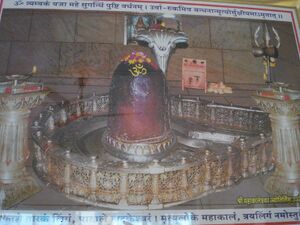
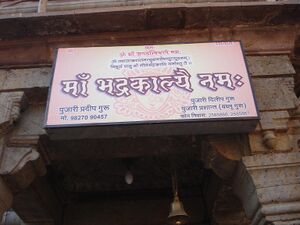
Mahakaleshwar Jyotirlinga is a famous Hindu temple dedicated to Lord Shiva and is one of the twelve Jyotirlingams, the sacred abodes of Shiva. It is located in the city of Ujjain, Madhya Pradesh state, India. It is a three-storey temple, on the side of the lake called Rudra Sagar.
The main deity, Shiva in the lingam form is believed to be swayambhu (born of itself), deriving currents of power (Shakti) from within itself as against the other images and lingams which are ritually established and invested with mantra-shakti. The idol of Mahakaleshwar is known to be dakshinamurti, facing the South. This is a unique feature, upheld by tantric tradition to be found only in Mahakaleshwar among the 12 jyotirlingas. The idol of Omkareshwar Shiva is consecrated in the sanctum above the Mahakal shrine. The images of Ganesh, Parvati and Kartikeya are installed in the west, north and east of the sanctum sanctorum. To the south is the image of Nandi.
The temple has five levels one of which is underground. The temple itself is located in a spacious courtyard surrounded by massive walls near a lake. The shikhara or the spire is adorned with sculptural finery. Brass lamps light the way to the underground sanctum.
The idol of Nagchandreshwar on the third storey is open for darshan only on the day of Nagapanchami.
The Paramara King Bhoja had constructed Mahakaleshwar temple between 1000-1050 AD. We also know from Udayaditya (1070-1080) prasasti at Udaipur as a Nagavanshi Inscription at Mahakal temple. Udayaditya was successor of Jayasimha. We know about nine Inscriptions of Udayaditya at Ujjain, Udaipur, Dhar Un and Kamed. He was responsible for construction of Nilakantheshwara temple at Udaipur. His Gold coins have been located at Indore. [33]
The Udaipur Stone Inscription of Udayaditya (EI,I,22) states that he was the son of Gyāta, the grandson of Goṇḍala. In the Pathashala of Bhoja, there is an inscription of two verses in Nagabandha figure composed by Udayaditya. Similar verses are also found at Ujjain and Un. He was follower of Shaivism. He granted the village of Vilapadraka to the temple of Somanatha, which was situated in the fort of Koshavardhana i.e. the modern Shergarh (EI, XXIII, pp.131ff). [34]
Bade Ganeshji ka Mandir
This temple, situated above the tank near the Mahakaleshwar Temple, contains a huge artistic sculpture of Ganesha, the son of Shiva. An idol of this size and beauty is rarely to be found. The middle of the temple is adorned by an idol of the panch-mukhi (five-faced) Hanuman. There is a provision for learning of Sanskrit and Astrology in the temple.
Chintaman Ganesh temple
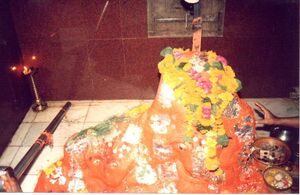
Chintaman means "the assurer of freedom from worldly anxieties". This temple is built across the Shipra river on the Fatehabad railway line. The Ganesh idol in this temple is supposed to be swayambhu - born of itself. Riddhi and Siddhi, the consorts of Ganesha, are seated on either side of Ganesha. The temple is considered to be of considerable antiquity. The artistically carved pillars in the assembly hall date back to the Paramara period. The temple is about 15 km from the main city. Every Wednesday people come for special darshana.
मध्यप्रदेश की धार्मिक नगरी उज्जैन में गणेशजी का एक सिद्ध स्थान है, जिसका नाम है चिंतामन गणेश मंदिर। मान्यता है कि इस मंदिर की स्थापना भगवान श्रीराम ने की थी। यहां आने वाले भक्तों की सभी चिंताएं गणेशजी दूर करते हैं। इसीलिए इन्हें चिंतामन गणेश कहा जाता है। श्रीराम ने वनवास काल में की थी इस मंदिर की स्थापना पुरानी मान्यताओं के अनुसार इस मंदिर का इतिहास रामायण काल से जुड़ा है। श्रीराम वनवास के दौरान उज्जैन भी आए थे। जब श्रीराम, सीता और लक्ष्मण के साथ इस क्षेत्र के वन में घूम रहे थे, तब सीता को प्यास लगी। सीता की प्यास बुझाने के लिए लक्ष्मण ने अपने बाण से एक बावड़ी बना दी थी। ये बावड़ी चिंतामन के पास ही स्थित है। श्रीराम को इस क्षेत्र की धरती दोषपूर्ण प्रतीत हो रही थी, इसीलिए उन्होंने यहां के दोष मिटाने के लिए गणेशजी का मंदिर स्थापित किया था। यही मंदिर चिंतामन गणेश के नाम से प्रसिद्ध है।[35]
Hara Siddhi Temple
This temple occupies a special place in the galaxy of ancient sacred spots of Ujjain. The temple is dedicated to Annapurna, seated between the idols of Mahalakshami and Mahasaraswati, the Annapurna is painted with a dark vermillion colour. The Shri Yatra, the symbol of power or shakti, is also enshrined in this temple. According to Shiva Purana, when Shiva carried away the burning body of Sati from the sacrificial fire, her elbow dropped at this place. There is an interesting legend in the Skanda Purana about the manner in which the Goddess Chandi acquired the epthet of Harassiddhi. Once whenShiva and Parvati were alone on mount Kailasha, two demons called Chanda and Prachanda tried to force their way in. Pleases Shiva bestowed upon her the epithet of Harasiddhi means 'one who vanquishes all'.
The temple was reconstructed during the Maratha period and has two pillars adorned with lamps, that are special features of Maratha art. There is an ancient well on the premises, and an artistic pillar adorns the top of it.
There are two temples in the Hara Siddhi Temple campus which go unnoticed. These are the Agasteshwara temple and the Karkoteshwara temple. They are associated with Agastya rishi and the Karkotaka which find mention in the ancient Jat History.
Kal Bhairava temple
The worship of the eight Bhairavas is a part of Saivite tradition, and the chief among them is Kala Bhairava. The Kal Bhairava temple is believed to have been built by King Bhadrasen, on the banks of the Shipra. Mentioned in the Avanti Khanda of the Skanda Purana. Important for the Tantric Kapalika and Aghora sects, of which Ujjain was a prominent centre. Beautiful paintings in the Malwa style once decorated the temple walls, only traces of which are visible. The village of Bhairogarh, famous for its printing, takes its name from the temple, and is located very near.
Mangalnath temple
Shiva or Mahadeva is the deity which is worshipped in Mangalnath temple. The Mangalnath temple is situated away from the bustle of the city and lokks down upon a vast expanse of the Shipra River. It is regarded as the birth place of Mars (mangala in hindi), according to the Matsya Purana. Famous for a clear view of the planet and hence suitable for astronomical studies.
Gopal Mandir
Constructed by Bayajibai Shinde, the queen of Maharajah Daulat Rao Shinde, in the 19th century. The door in the inner sanctum is believed to have been carried to Ghazni from the Somnath temple and from thence by Mahmud Shah Abdali to Lahore, from where it was rescued by Mahadji Scindia.
Other temples
- Navagraha Mandir (Triveni) - A temple dedicated to the nine planets.
- Ram Janardhan Temple.
- Harihara Tirtha.
- Mallikarjuna Tirtha.
Pir Matsyendranath
This is very attractive spot on the banks of Shipra River, quite close to the Bhartrihari Caves and the Gadkalika temple. The shrine is dedicated to a leader of the Natha sect of Shaivism- Matsyendranath. It is also venerated by Muslims. Excavations here have yielded artifacts dating to the 6th and 7th century BC.
Siddhavat
Features an enormous banyan tree on the banks of the Shipra, considered sacred since the medieval ages. This banyan tree has got the same significance as that of akshayavata in Prayag and Gaya, Vanshivata of Vrindavan and Panchavata of Nasik. Thousands of people take dip in the Shipra River from the bathing ghats built here. According to one tradition, Parvati is believed have performed her penance here. It used to be a place of worship for the followers of the Natha sect. The little village of Bhairogarh near Siddhawat is famous for its tie-and-die printing for centuries. In ancient times, when the trade with other counties flourished, exquisitely printed cloth from Bhairogarh used to find its way to Rome and China.
Bhartrihari Caves
Bhartrihari, the step brother of Vikramaditya, is believed to have lived and meditated here after renouncing worldly life. His famous works, Shringarshataka, Vairagyashataka, and Nitishataka, were possibly written here.
Kaliadeh Palace
It is situated on the banks of Shipra River and a beautiful ancient site. It is believed that there was once a majestic Sun temple at this site. The Avanti-mahatmya of Skanda Purana has recorded a description of the Sun temple and two tanks, The Surya Kunda and the Brahma Kunda. Remains of old temple are scattered all around. A fragmented inscription of this place records building of the palace in 1458 AD, in the time of Mahmud Khilji. The central dome of the palace is a beautiful example of Persian architecture. Two Persian inscriptions record the visits of Akbar and Jehangir to this palace. The palace was broken by the Pindaris and was restored by Madhav Rao Scindia in 1920.
Sandipani Ashram
Ujjain in ancient times, enjoyed the reputation of being a great seat of learning as early as the Mahabharata period. According to Puranic traditions, in the Ashrama of Guru Sandipani, Krishna and Sudama received their education. The area near the ashrama is known as ankapata, popularly believed to have been the place used by Lord krishna for washing his writing tablet. The numerals 1 to 100 found on a stone are believed to have been engraved by Guru Sandipani. the Gomti Kunda, referred to in the Puranas, was the source of water supply to the ashrama in the olden days. An image of Nandi, belonging to the Shunga period, is to be found near the tank. The followers of the Vallabha sect regard this place as the 73rd seat of the 84 seats of Vallabhacharya where he delivered his discourses throughout India.
Durgadas Ki Chhatri
Durgadas fought for the independence of Jodhpur after the death of Maharaja Jaswant Singh and helped Ajit Singh to ascend the throne against the wishes of Aurangzeb. Durgadas died at Rampura in 1718 and his funeral rites were performed according to his wishes on the banks of Shipra River. The rulers of Jodhpur built the Chatri as Memorial to Durgadas, whose funeral rites were performed at this place in 1718. This structure built in Rajpur style of architecture, housed a statue of Durgadas which crumbled down.
Gadkalika
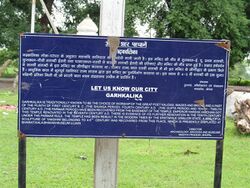
Gadkalika, situated about two miles from the present town, the deity in this temple is believed to have been worshiped by Kalidasa. The legend goes that he was an idiot and it is by this devotion to the goddess Kalika that he acquired great literary skill. Believed to have been frequented by Kalidasa, this temple was renovated by Harshavardhan in the 7th century AD, and again during the Paramara period. The temple has been rebuilt in the modern times by the erstwhile Gwalior State.
Bhairogarh
- Read more at Bhairogarh
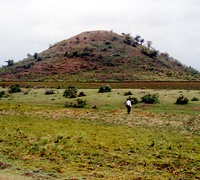
Bhairogarh is main site of ancient Ujjain, containing the remains of structures which are dated to 3rd -2nd Century B.C.[36]
Ancient Mound (Vaishya Tekri): This site at Undasa is a part of ancient Ujjain. Structural remains of Mauryan period have been found. Stupas are the conspicuous evidence of ancient habitation. [37]
Kumhar Tekri: Paleo-Pathology of Ancient Skeletal Remains - Dr. Veena Mushrif-Tripathy (2008), Visiting Fellow of the Anthropological Survey of India has submitted her year long work in the An.S.I. in the form of a report entitled ‘Human skeletal remains from the sites of Sarai Nahar Rai (Mesolithic) and Kumhar Tekri (Early Historic)’. In the report, she made a strong case for a ‘National Facility for Human Skeletal Research’, a centre for research comprising the skeletal repository with in the Anthropological Survey of India.[38]
Other places
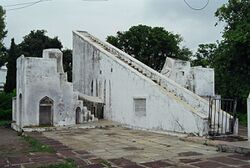
- Vedhashala - An observatory built by Raja Jai Singh II (1686-1743). It is located at 23|10|16.5|N|75|46|0|E. It is still in use, and is one of the five he built (the others include the Yantra mandir (Jaipur) and the Yantra Mandir (Delhi).
- Ram Ghat.
- Ganga Ghat.
- Bohron Ka Roja.
- Begum Ka Maqbara.
- Bina Neev Ki Masjid.
- Maulana Rumi Ka Maqbara.
84 Gods of Ujjain
There are 84 Gods of Ujjain, Chaurasi Ishwaras, out of them four are the dwarapalas of Mahakala Ujjain. The four dwarapalas are Pingaleshwara (East), Kayavarohaneshwara (South), Vilveshwara (West) and Dardareshwara (North). The Chaurasi Ishwaras are:
- Abhayeshwara Mahadeva (अभयेश्वर महादेव) ,
- Abhimukteshwara Mahadeva (अभिमुक्तेश्वर महादेव) ,
- Agasteshwara Mahadeva (अगस्तेश्वर महादेव) ,
- Akrureshwara Mahadeva (अक्रूरेश्वर महादेव) ,
- Anadikalpeshwara Mahadeva (अनादिकल्पेश्वर महादेव) ,
- Anandeshwara Mahadeva (आनन्देश्वर महादेव) ,
- Anarkeshwara Mahadeva (अनर्केश्वर महादेव) ,
- Angarakeshwara Mahadeva (अन्गारकेश्वर महादेव) ,
- Apsareshwara Mahadeva (अप्सरेश्वर महादेव) ,
- Aruneshwara Mahadeva (अरुणेश्वर महादेव) ,
- Badaleashwara Mahadeva (बड़लेश्वर महादेव) ,
- Bilkeshwara Mahadeva (बिल्केश्वर महादेव) ,
- Brahmeshwara Mahadeva (ब्रह्मेश्वर महादेव) ,
- Chandradityeshwara Mahadeva (चंद्रादित्येश्वर महादेव) ,
- Chyavaneshwara Mahadeva (च्यवनेश्वर महादेव) ,
- Damarukeshwara Mahadeva (डमरुकेश्वर महादेव) ,
- Duddhareshwara Mahadeva (दुद्धरेश्वर महादेव) ,
- Dudeshwara Mahadeva (दुदेश्वर महादेव) ,
- Durdureshwara Mahadeva (दुर्दुरेश्वर महादेव) ,
- Gangeshwara Mahadeva (गंगेश्वर महादेव) ,
- Ghanteshwara Mahadeva (घंटेश्वर महादेव) ,
- Gurihashwara Mahadeva (ग़ुरिहश्वर महादेव) ,
- Hanumanteshwara Mahadeva (हनुमंतेश्वर महादेव) ,
- Indradhamneshwara Mahadeva (इन्द्रधम्नेश्वर महादेव) ,
- Indreshwara Mahadeva (इन्द्रेश्वर महादेव) ,
- Ishaneshwara Mahadeva (ईशानेश्वर महादेव) ,
- Jalpeshwara Mahadeva (जल्पेश्वर महादेव) ,
- Jateshwara Mahadeva (जटेश्वर महादेव) ,
- Kalakaleshwara Mahadeva (कलकलेश्वर महादेव) ,
- Kameshwara Mahadeva (कामेश्वर महादेव) ,
- Kandhadeshwara Mahadeva (कन्धड़ेश्वर महादेव) ,
- Kantheshwara Mahadeva (कंठेश्वर महादेव) ,
- Kapaleshwara Mahadeva (कपालेश्वर महादेव) ,
- Karabheshwara Mahadeva (करभेश्वर महादेव) ,
- Karkateshwara Mahadeva (कर्कटेश्वर महादेव) ,
- Karkoteshwara Mahadeva (कर्कोटेश्वर महादेव) ,
- Kayavarohaneshwara Mahadeva (कयावरोहणेश्वर महादेव) ,
- Kedareshwara Mahadeva (केदारेश्वर महादेव) ,
- Khandeshwara Mahadeva (खंडेश्वर महादेव) ,
- Kukkuteshwara Mahadeva (कुक्कुटेश्वर महादेव) ,
- Kundeshwara Mahadeva (कुण्डेश्वर महादेव) ,
- Kusumeshwara Mahadeva (कुसुमेश्वर महादेव) ,
- Kutumbeshwara Mahadeva (कुटुम्बेश्वर महादेव) ,
- Lokapaleshwara Mahadeva (लोकपालेश्वर महादेव) ,
- Lumpeshwara Mahadeva (लुम्पेश्वर महादेव) ,
- Mahalayeshwara Mahadeva (महालयेश्वर महादेव) ,
- Markandeshwara Mahadeva (मारकंडेश्वर महादेव) ,
- Matangeshwara Mahadeva (मातंगेश्वर महादेव) ,
- Meghanadeshwara Mahadeva (मेघनादेश्वर महादेव) ,
- Mukteshwara Mahadeva (मुक्तेश्वर महादेव) ,
- Nagachandreshwara Mahadeva (नागचंद्रेश्वर महादेव) ,
- Nripareshwara Mahadeva (नृपरेश्वर महादेव) ,
- Onkareshwara Mahadeva (ओंकारेश्वर महादेव) ,
- Pantaneshwara Mahadeva (पन्तनेश्वर महादेव) ,
- Pashupateshwara Mahadeva (पशुपतेश्वर महादेव) ,
- Pingaleshwara Mahadeva (पिंगलेश्वर महादेव) ,
- Pishachamukteshwara Mahadeva (पिशाचमुक्तेश्वर महादेव) ,
- Pratihareshwara Mahadeva (प्रतिहारेश्वर महादेव) ,
- Prayageshwara Mahadeva (प्रयागेश्वर महादेव) ,
- Prithukeshwara Mahadeva (पृथुकेश्वर महादेव) ,
- Pushpadanteshwara Mahadeva (पुष्पदंतेश्वर महादेव) ,
- Rajasthaleshwara Mahadeva (राजस्थलेश्वर महादेव) ,
- Rameshwara Mahadeva (रामेश्वर महादेव) ,
- Revanteshwara Mahadeva (रेवंतेश्वर महादेव) ,
- Rupeshwara Mahadeva (रूपेश्वर महादेव) ,
- Sahastradhanukareshwara Mahadeva (सहस्त्रधनुकारेश्वर महादेव) ,
- Sangameshwara Mahadeva (संगमेश्वर महादेव) ,
- Saubhageshwara Mahadeva (सौभागेश्वर महादेव) ,
- Shiveshwara Mahadeva (शिवेश्वर महादेव) ,
- Shrisiddheshwara Mahadeva,
- Shriswapneshwara Mahadeva (श्रीस्वप्नेश्वर महादेव) ,
- Shuleshwara Mahadeva (शूलेशवर महादेव) ,
- Siddheshwara Mahadeva (सिद्धेश्वर महादेव) ,
- Singheshwara Mahadeva (सिंहेश्वर महादेव) ,
- Someshwara Mahadeva (सोमेश्वर महादेव) ,
- Sthawareshwara Mahadeva (स्थावरेश्वर महादेव) ,
- Swargadwareshwara Mahadeva (स्वर्गद्वारेश्वर महादेव) ,
- Swarnajaleshwara Mahadeva (स्वर्णजालेश्वर महादेव) ,
- Trilochaneshwara Mahadeva (त्रिलोचनेश्वर महादेव) ,
- Trivishtapeshwara Mahadeva (त्रिविष्टपेश्वर महादेव) ,
- Uttareshwara Mahadeva (उत्तरेश्वर महादेव) ,
- Vireshwara Mahadeva (वीरेश्वर महादेव) ,
- Vishvareshwara Mahadeva (विश्वरेश्वर महादेव) ,
- Yageshwara Mahadeva (याज्ञेश्वर महादेव) ,
Picture gallery
-
Mahakal Temple Ujjain 1889
-
Kalabhairava Idols Ujjain
-
Statues at Kalbharav Temple Ujjain
-
Coin showing Karttikeya and Lakshmi (Ujjain, circa 150–75 BC)
External links
- [2] Description and photographs of the Veda Shala.
- [3] Description of monuments, from the district administration.
Notable persons
- Raju Jat (Bhakal) - Jat Dharmshala Ujjain, Mob: 9977002949
- रामा जाट महरिया - नागौर के ढींगसरा के थे । 175 वर्ष पूर्व रेवड़ चराने गये थे फिर उज्जैन बस गये । उनके लडकी ही थी ।अतः उन्होंने अपने दोहिते बिडियासर को गोद लिया । ढीगसरा केश्री अर्जुनजी महरिया भी थे।
Gallery
-
Santosh Kumar Jat, District Commandant,Home Guard, Ujjain.
-
Bhawar Lal Jat evam Smt. Halki Bai, Ujjain.
-
मनोज कुमार जाट एवं श्रीमती राधा मनोज कुमार जाट
-
Mukesh Kumar Choudhari Evan pariwar, Ujjain.
-
Smt Radha evam km Teena Jat
-
Shri Jat Dharma Shala, Ankpat road, Ujjain
-
Shri Jat Dharma Shala, Ankpat road, Ujjain
References
- ↑ Room A. Placenames of the world: origins and meanings, p. 12.
- ↑ Ram Swarup Joon: History of the Jats
- ↑ Dr Mahendra Singh Arya, Dharmpal Singh Dudi, Kishan Singh Faujdar & Vijendra Singh Narwar: Ādhunik Jat Itihas (The modern history of Jats), Agra 1998
- ↑ Dr Mahendra Singh Arya, Dharmpal Singh Dudee, Kishan Singh Faujdar & Vijendra Singh Narwar: Ādhunik Jat Itihas (The modern history of Jats), Agra 1998, p. 234
- ↑ आवन्त्यांश्च वशे कृत्वा साम्ना च भरतर्षभ, वृष्णिभिः सह संम्य पश्चिमामपि निर्जयत् (3-255-17)
- ↑ V. S. Agrawala: India as Known to Panini, 1953, p.60, 425
- ↑ V. S. Agrawala: India as Known to Panini, 1953, p.89
- ↑ V. S. Agrawala: India as Known to Panini, 1953, p.506
- ↑ V. S. Agrawala: India as Known to Panini, 1953, p.509
- ↑ V. S. Agrawala: India as Known to Panini, 1953, p.60
- ↑ James Tod: Annals and Antiquities of Rajasthan, Volume I, Annals of Mewar,p.249
- ↑ D'Anville {Antiquites de l'Inde) quotes Nicolas of Damascus as his authority, who says the letter written by Porus, prince of Ozene, was in the Greek character.
- ↑ James Tod: Annals and Antiquities of Rajasthan, Volume I, Annals of Mewar,p.249,fn-5
- ↑ This is not certain (Smith, EHI, 60, note).
- ↑ Rajatarangini of Kalhana:Kings of Kashmira/Book III,p.39
- ↑ Rajatarangini of Kalhana:Kings of Kashmira/List of Kings,p.
- ↑ Rajatarangini of Kalhana:Kings of Kashmira/Book IV,p.68-69
- ↑ Dasharatha Sharma, Early Chauhan Dynasties", Ch. XI, pp. 123-124.
- ↑ Studies in the Geography of Ancient and Medieval India, By Dineschandra Sircar, p.319
- ↑ R.C. Majumdar, Hindu Colonies in the Far East,1944,p.216
- ↑ The Ancient Geography of India/Maheswarapura, p.489-490
- ↑ Julien's ' Hiouea Thsang,' iii. 167. See Map No. I.
- ↑ Aitihasik Sthanavali by Vijayendra Kumar Mathur, p.933
- ↑ Aitihasik Sthanavali by Vijayendra Kumar Mathur, p.721
- ↑ Aitihasik Sthanavali by Vijayendra Kumar Mathur, p.87-88
- ↑ Aitihasik Sthanavali by Vijayendra Kumar Mathur, p.45-47
- ↑ Thakur Deshraj:Jat Itihas (Utpatti Aur Gaurav Khand)/Ashtam Parichhed,p.137-138
- ↑ Bhim Singh Dahiya, IRS: Jats the Ancient Rulers (A clan study), First Edition 1980, Publisher: Sterling Publishers Pvt Ltd, AB/9 Safdarjang Enclave, New Delhi-110064, p.xiii
- ↑ [1]
- ↑ Jat Vaibhav Smarika Khategaon, 2010, p. 56
- ↑ Jat Vaibhav Smarika Khategaon, 2010, p. 69
- ↑ Jat Vaibhav Smarika Khategaon, 2010, p. 72
- ↑ Archaeological excavations in central India: Madhya Pradesh and Chhattisgarh By R. K. Sharma, Om Prakash Misra, p. 12
- ↑ Malwa through the ages, from the earliest times to 1305 A.D. By Kailash Chand Jain, p.357
- ↑ [http://m2.bhaskar.com/news/religion-badikhabarein/9250/JM-TID-one-temple-which-was-established-by-lord-rama-himself-in-hindi-5217474-PHO.html एक ऐसा मंदिर जिसकी स्थापना खुद श्रीराम ने की थी Dainikbhaskar.com Jan 9, 2016,]
- ↑ asibhopal.nic.in
- ↑ asibhopal.nic.in
- ↑ https://ansi.gov.in/paleo-anthropology/
Back to Places/Madhya Pradesh





